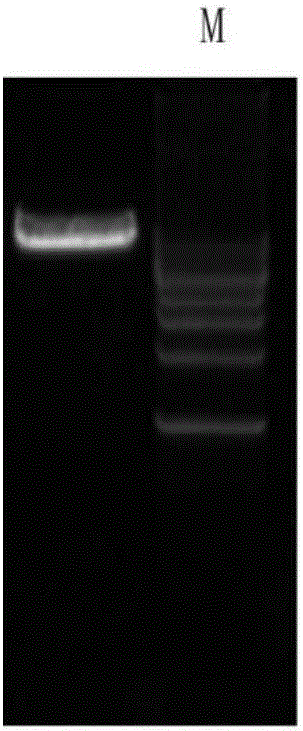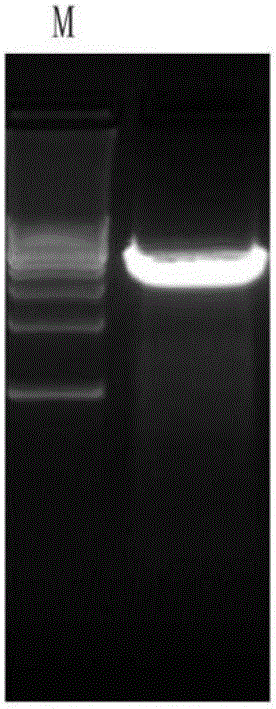Method for obtaining sheep with different hair colors on basis of CRISPR/Cas9 and sgRNA of targeted ASIP gene
A technology of sheep and genes, applied in the direction of DNA/RNA fragments, other methods of inserting foreign genetic materials, genetic engineering, etc., to achieve the effect of simple construction steps, high specificity, and shortened experimental period
- Summary
- Abstract
- Description
- Claims
- Application Information
AI Technical Summary
Problems solved by technology
Method used
Image
Examples
Embodiment 1
[0035] Embodiment 1, preparation sgRNA and Cas9mRNA
[0036] 1. Design the target sequence of sheep ASIP gene and the sgRNA that recognizes the target sequence
[0037] The full-length sequence of the sheep ASIP gene is shown in GENBANK ACCESSION NO.NC_019470 (VERSIONNC_019470.1; GI:417531912; linear CON 03-APR-2015).
[0038] Sequence 1 of the sequence listing is a partial segment of the sheep ASIP gene, which has three exons (222-381 nucleotides, 795-859 nucleotides, 1222-1398 nucleotides), It encodes the protein shown in Sequence 2 of the Sequence Listing.
[0039] After a lot of pre-tests and verification tests, the 359th-378th nucleotides in sequence 1 in the sequence listing were selected as the target sequence of the sgRNA for the sheep ASIP gene.
[0040] 2. Preparation of sgRNA ASIP
[0041] 1. Use restriction endonuclease BbsI enzyme single digestion px330 plasmid, then carry out 1% agarose gel electrophoresis (the 1% agarose gel electrophoresis figure of restric...
Embodiment 2
[0052] Example 2, Detection of the Mutation Efficiency of Injected sgRNA / Cas9mRNA Embryos
[0053] 1. Obtaining fertilized sheep eggs
[0054] 1. Oocyte maturation
[0055] Collect sheep ovaries from the slaughterhouse (the ovaries are from Kazakh sheep), wash them with normal saline for 3-4 times, extract the oocytes, wash them with maturation solution for 3-4 times, and then drop them into well-balanced maturation solution (maturation solution The volume of the drop is 75-78μl, and each drop is filled with 25-30 oocytes), and placed in a solution containing 5% CO 2 cultured in a 38.6°C incubator (the following incubator cultures are all under the same conditions).
[0056] Equilibrate the mature solution: place the mature solution drop in the incubator for 2h. Maturation solution: TCM199 culture solution + 10% by volume FBS + 0.05IU / ml FSH + 0.05IU / ml LH + 1μg / ml estradiol + 24.2μg / ml sodium pyruvate + 0.1mM / L cysteine +10ng / ml EGF+100IU / ml penicillin+100IU / ml streptomyc...
Embodiment 3
[0077] Example 3, Production of gene-edited sheep
[0078] 1. Selection of experimental sheep
[0079] Xinjiang fine-wool sheep with good body condition, no reproductive diseases and 2-4 years old were selected as donor ewes. Select the Altay sheep with a weight of more than 50kg, an age of 2-4 years, good body condition and no reproductive diseases as recipient ewes. Select Xinjiang fine-wool sheep with a body weight of 70-85kg, excellent semen detection and 1-3 years old as semen collection rams.
[0080] 2. Synchronous estrus and superovulation
[0081] During the estrous cycle of the sheep, the donor ewes were put into the vagina of the CIDR vaginal suppository, and on the 10th day after the CIDR vaginal suppository was put in, FSH (Ningbo Sansheng Company, China) was injected continuously in a decreasing manner, once every 12 hours, for a total of 3 days , the total dose is 240 units / only, take out the CIDR suppository in the morning of the 12th day, wash the vagina, a...
PUM
 Login to View More
Login to View More Abstract
Description
Claims
Application Information
 Login to View More
Login to View More - R&D
- Intellectual Property
- Life Sciences
- Materials
- Tech Scout
- Unparalleled Data Quality
- Higher Quality Content
- 60% Fewer Hallucinations
Browse by: Latest US Patents, China's latest patents, Technical Efficacy Thesaurus, Application Domain, Technology Topic, Popular Technical Reports.
© 2025 PatSnap. All rights reserved.Legal|Privacy policy|Modern Slavery Act Transparency Statement|Sitemap|About US| Contact US: help@patsnap.com



